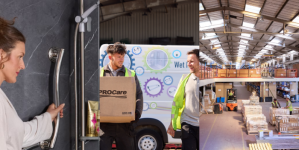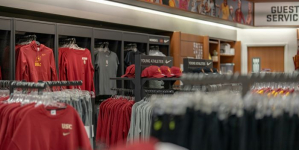-
AI startup Onton raises $7.5M to reinvent the way the world discovers and decides what to buy - November 26, 2025
-
Forklift Market Positions for Recovery as Confidence Expected to Build from 2026 - November 26, 2025
-
PROCare achieves 300% order capacity increase and 99% picking accuracy with Forterro’s ERP solution, Orderwise - November 26, 2025
-
DHL boosts operational efficiency and customer communications with HappyRobot’s AI Agents - November 25, 2025
-
STENA LINE TEAMS UP WITH CAMERA TELEMATICS TO DRIVE SAFETY IMPROVEMENTS AT IRISH SEA PORTS - November 25, 2025
-
Another design award for Toyota’s lithium-ion Traigo_i counterbalanced forklift - November 21, 2025
-
Stuut Technologies Raises $29.5 Million Series A Led by Andreessen Horowitz to Automate Accounts Receivable Work - November 20, 2025
-
INCREASED DIGITAL INVESTMENT REQUIRED TO KEEP PACE WITH 2026 CUSTOMS CHANGES - November 19, 2025
-
FULFILMENT SOLUTIONS FOR SPORTS MERCHANDISE: KEEPING OUR EYE ON THE GAME - November 19, 2025
-
COMPLEX, COSTLY & CONFUSING – THE END OF DE MINIMIS - November 19, 2025
Automated response requires smooth operators.
Edward Hutchison, Managing Director of BITO Storage Systems, looks at the proposition of an automated response to logistics challenges.
Automation is stepping closer into the economic justification zone for more operators who are juggling higher volumes, a growing demand for faster order fulfilment and greater value on the one hand, with rising staff costs on the other. The logistics sector has always leaned heavily on manual labour, but the combination of falling unemployment levels, minimum wage rises and a potentially reduced labour pool from the post-Brexit EU has changed the cost equation.
A further factor pushing automation into this zone is a dearth of available warehouse property, especially close to the urban areas where the greater proportion of the population now live, putting space at a premium.
In addition to these market trends, automation’s modularity, sophisticated control systems, and performance developments can create a more practical and flexible solution for a greater variety of applications – from fulfilling omnichannel retail to supplying line-side manufacturing.
All of these factors are merging into a trend that is seeing automated, ‘goods to picker’ based order picking installations increasingly being integrated into intralogistics systems.
Small parts
For operations looking to concentrate onto a small footprint large volumes of smaller items, of which only a limited quantity is picked at any one time, automated bin storage systems provide a compact solution. Installations can be designed for single or double deep storage and the bay width could allow one or several bins and trays to be stocked in the same bay.
Bins or trays are fed in and out of the system by automated stacker cranes. With their lightweight construction and state of the art control, they achieve the high performance required to ensure continuous supply to work stations of goods to be picked, as well as an uninterrupted return of bins to their storage location.
Automated bin storage picking systems occupy considerably less space than manual counterparts – a high-bay racking construction will make full use of the available warehouse height. These systems also reduce picking times. This is thanks to optimising the ergonomic layout of the picking area, reduced travel time – often by more than 80% – and very short access times as every bin location is immediately accessible. Controlled by sophisticated warehouse management systems, it’s a solution that will guarantee good availability of product lines and allow full stock control.
Automated support for live storage
Live storage can offer a lower cost alternative to automated storage and retrieval systems for dense storage of pallets or cartons. However, the two systems can also complement one another – with automated stacker cranes replenishing the live storage by feeding products into the flow lanes where they travel on rollers to the pick face at the front, allowing orders to be picked directly into their related bins. These can be transported unassisted on integrated conveyors.
For most integrated automated storage and retrieval systems, Return On Investment (ROI) remains a matter of years rather than months. For those more trepidatious about the ROIs of automation, there it is always possible to take a stepped approach. Starting with lower levels of automated systems such as BITO’s recently launched LEO locative internal transportation system. Or adding integrated conveyors and technology such as pick to light to carton and pallet live storage.
Then there are the semi-automated solutions such as BITO’s PROmotion shuttle. This deep lane storage and retrieval system provides a high degree of storage density and an interesting alternative to drive-in, push-back and pallet live storage systems. Remote-controlled shuttles move pallets to the back and to the front of a lane. They can be placed into a lane and relocated into another lane with a standard forklift truck, which will also assume pallet in-feeding and out-feeding.
Mobile racking also adds an element of automation that works in tandem with conventional lift trucks to provide denser storage than is possible with standard pallet racking, Depending on the system is installed, storage capacity can be increased by up to 180% and floor space occupation can be reduced by up to 50%.
No matter what the application, to gain the biggest advantage from automated storage and retrieval systems, you will need to pay attention to the design of the racking. This requires sourcing racking from a supplier that can provide uprights in a range of widths to allow optimum adaptation to different load requirements and building constraints. Beams that can be adjusted in small increments will allow, with careful design, the maximum utilisation of the full building height.
The racking will also contribute to ensuring a smooth operation – which is vital for the performance benefits of an automated system to be realised. Fine tolerances in the racking’s manufacture and installation are needed for the stacker crane to run smoothly, with trouble-free operation and maximum safety. The bins and racking should be designed to suit – ie fit snugly into the bays without wasting space yet still move smoothly when putaway or retrieved. Sourcing bins and racking separately can increase the risk of jams, causing disruption to operations.
A single source supplier, which manufactures shelving and racking systems as well as bins and trays will be able to supply specially designed bins and trays that have been perfectly adapted to automated racking and stacker crane conditions and meet the requirements of the system. For example, BITO XL series stacker containers, KLT small parts containers, and trays made from steel sheet or polypropylene, all meet the requirements of automated bin storage and are suited for any application.
If you have decided to move from manual intralogistics to any form of automated system, to help meet your challenges, the last thing you will want is a system that fails to live up to its promised performance. It is all too easy to assume that it will be hit by focusing on the automation technology bit. But the performance will only be achieved if the design and installation of the racking and bins allows a smooth operation. As a customer about to make a large investment on racking and bins or trays for an automated system, you need to look a supplier in the eye and ask: ‘can you provide this?”

































